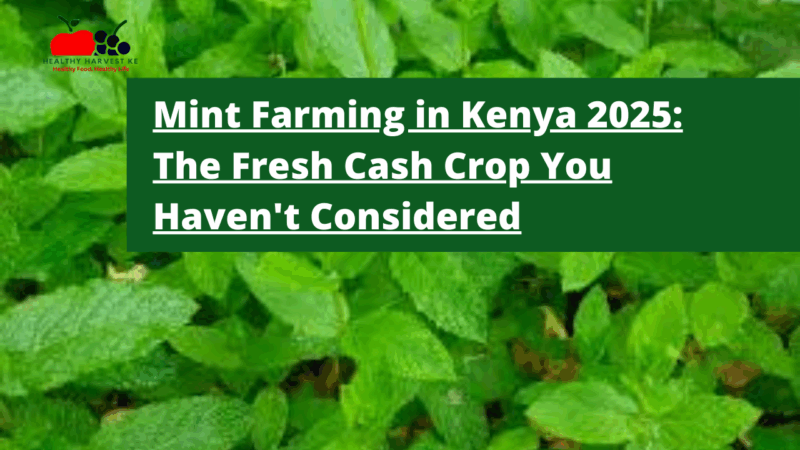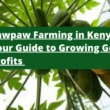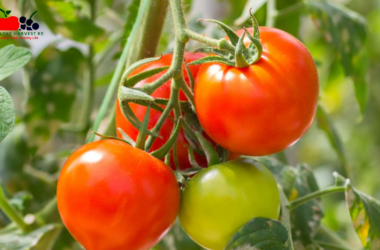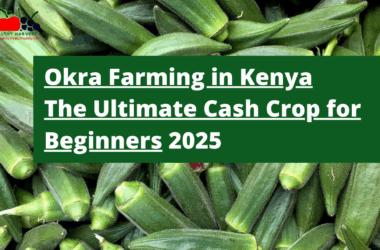You’ve probably walked past mint countless times in the supermarket—that fragrant herb sitting in small bunches next to cilantro and basil. But have you ever thought about growing it as a serious cash crop? If you’re looking for an agricultural venture that doesn’t require massive land or investment, mint farming in Kenya might be your next smart move.
What Makes Mint a Game-Changing Crop for Kenyan Farmers
Tired of the same old crops with unpredictable markets? Mint is changing the agricultural game in Kenya, and for good reason. This aromatic herb isn’t just easy on the nose—it’s surprisingly easy on your resources too.
Unlike traditional crops that dominate Kenya’s farming landscape, mint offers multiple harvests throughout the growing season. Once established, you can harvest every 10 days, creating consistent income rather than the feast-or-famine cycle many farmers face with seasonal crops.
The best part? Mint grows in Kenya’s diverse climate zones. Whether you’re in the highlands of Central Kenya or the moderate altitudes of the Rift Valley, there’s a mint variety that will thrive on your land.
The Mint Varieties That Thrive in Kenyan Soil
Not all mint is created equal. Each variety has its own personality, market, and growing requirements. Here’s what works best in Kenya:
Spearmint: The Kenyan Favorite
Spearmint is the rock star of Kenyan mint farming. It’s adaptable, hardy, and has a sweet flavor profile that makes it perfect for culinary uses. Most farmers start with spearmint because it’s forgiving for beginners and has established market demand both locally and internationally.
Peppermint: The Premium Option
If you’re looking to command higher prices, peppermint is your go-to. Its intense cooling sensation and higher menthol content make it valuable for both culinary and medicinal applications. The essential oil extraction from peppermint can be a lucrative value-addition venture if you’re ready to scale up.
Specialty Mints: For Niche Markets
For those looking to supply specialty markets, apple mint and Moroccan mint offer unique opportunities. Apple mint’s mild, fruity flavor is perfect for teas and garnishes, while Moroccan mint (a spearmint cultivar) is prized for its intense flavor in North African cuisine.
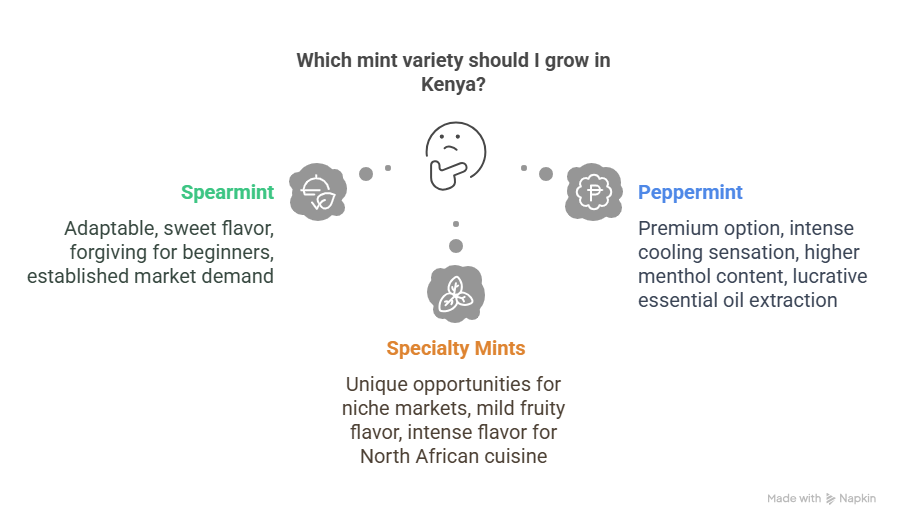
Getting Started: The Nuts and Bolts of Mint Cultivation
Ready to get your hands dirty? Here’s what you need to know before you plant your first mint seedling:
Climate and Location: Finding Your Sweet Spot
Mint thrives in cool, moist environments with temperatures between 15°C and 25°C. This makes the highlands of Central Kenya, parts of the Rift Valley, Eastern, and Western regions ideal for cultivation.
If you’re in Nakuru, Murang’a, Kiambu, or Kitengela, you’re already in prime mint territory. These areas have proven successful for both small-scale farmers and export companies.
Soil Prep: Building the Foundation
Mint isn’t particularly picky, but it does have preferences. Your soil should be:
- Well-drained but moisture-retentive
- Rich in organic matter
- pH between 6.0 and 7.0
Before planting, work compost or well-rotted manure into your soil. This not only improves drainage but adds the organic matter mint loves. Regular soil testing is worth the investment—it helps you adjust nutrients specifically for mint’s needs.
Water Systems: The Key to Success
Let’s be clear: mint loves water. You’ll need a reliable water source and efficient irrigation system. Many successful mint farms are located near rivers or have installed drip irrigation systems.
Without adequate water, both your yield and the essential oil content of your mint will suffer. Consider water harvesting systems if you’re in an area with seasonal rainfall.
Planting and Propagation: Three Ways to Get Growing
When it comes to starting your mint farm, you have options:
From Seeds: The Patient Approach
Starting from seeds is the most affordable but slowest method. Sow seeds about 6mm deep in prepared beds or seedling trays. They’ll typically sprout within 10-15 days at room temperature. Transplant seedlings when they have at least two sets of true leaves.
From Cuttings: The Quick Start
Take 10-15cm stem cuttings from healthy mint plants, remove the lower leaves, and place them in water or damp soil. Roots usually develop within 10-14 days. This method gives you plants identical to the parent and a faster start than seeds.
From Rhizomes: The Commercial Choice
For commercial production, dividing rhizomes (underground stems) is often preferred. Cut sections of rhizome with buds attached and plant them horizontally about 2-3cm deep. This method establishes quickly and maintains the characteristics of the parent plant.
Whichever method you choose, space your plants 45-60cm apart to allow for proper growth and air circulation.
Day-to-Day Management: Keeping Your Crop Thriving
Once your mint is established, these practices will keep it healthy and productive:
Regular Pinching and Pruning
Mint grows like it’s trying to take over the world. Regular pinching of stem tips encourages bushy growth with more leaves (where all the valuable essential oils are stored). Remove flowers as they appear to redirect the plant’s energy to leaf production.
Mulching: A Multi-Purpose Solution
A good layer of organic mulch around your mint plants serves multiple purposes:
- Conserves soil moisture
- Suppresses weed growth
- Keeps leaves clean from soil splash
- Slowly adds nutrients as it breaks down
Straw, dried grass clippings, or leaf litter make excellent mulch for mint.
Pest and Disease Management: The Organic Approach
While mint is naturally resistant to many pests thanks to its aromatic oils, you might encounter issues with aphids, spider mites, or cutworms. These pests can cluster on new growth, causing leaf curling and distortion.
Integrated pest management works best for mint:
- Encourage beneficial insects like ladybugs and lacewings
- Apply neem oil or insecticidal soap for severe infestations
- Maintain good air circulation between plants
- Remove and destroy heavily infested plant material
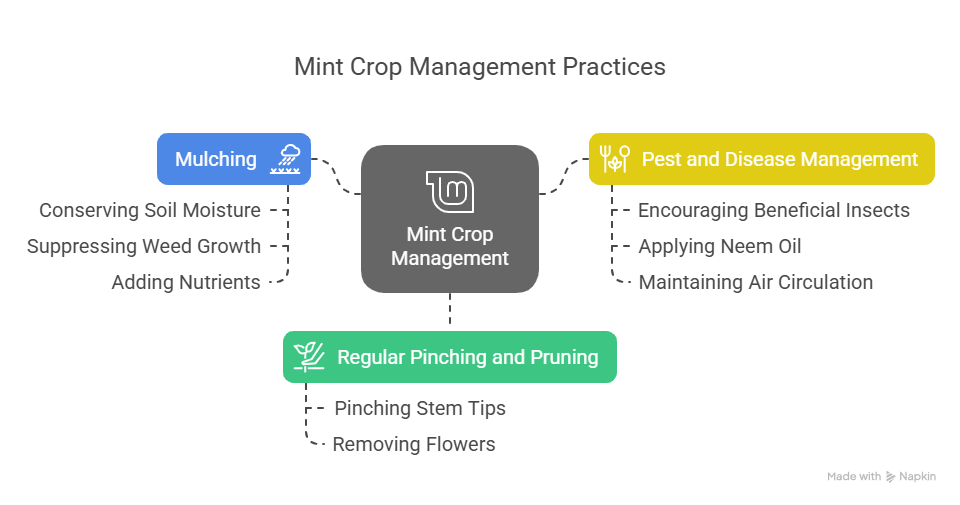
Harvesting Your Green Gold
Harvesting mint is both an art and a science. The timing and technique significantly impact the quality and yield of your crop.
When to Harvest
For the highest essential oil content, harvest mint just before flowering, when the plant is about 15-20cm tall. The nascent shoots contain the highest concentration of flavor and aroma. This typically occurs 45-90 days after planting, depending on growing conditions.
Harvesting Technique
Cut stems 5-8cm above the soil line, preferably in the morning after dew has dried but before the heat of the day. Morning harvests yield the highest essential oil content. Use clean, sharp shears to avoid damaging the plants.
After the first harvest, your mint will regrow, allowing for additional harvests approximately every 10 days throughout the growing season.
From Farm to Market: Selling Your Mint
Growing mint is only half the battle. Knowing where and how to sell it makes the difference between a hobby and a profitable business.
Fresh Mint Markets
Fresh mint has a ready market in:
- Local supermarkets and grocery stores
- Restaurants and hotels
- Farmers’ markets
- Food processing companies
Fresh mint should be delivered quickly after harvest, ideally within 24 hours, to maintain quality and freshness.
Value-Added Products
To increase your profits, consider processing your mint into:
- Dried mint leaves for tea and culinary uses
- Essential oils for aromatherapy and flavoring
- Mint-infused products like soaps and lotions
These products have longer shelf lives and often command higher prices than fresh mint.
The Real Numbers: Investment and Returns
Let’s talk money—what does it actually cost to start a mint farm, and what can you expect in return?
Initial Investment
For a one-acre mint farm in Kenya, expect these approximate startup costs:
- Land preparation: Ksh 20,000 – 45,000
- Propagation materials: Ksh 2,000 – 25,000 (depending on method)
- Basic irrigation setup: Ksh 50,000 – 100,000
- Tools and equipment: Ksh 15,000 – 30,000
Total initial investment: Ksh 87,000 – 200,000 depending on your existing resources and scale.
Potential Returns
A well-managed acre of mint can yield 3-5 tons of fresh mint per year through multiple harvests. Current market prices range from Ksh 80-200 per kilogram for fresh mint, depending on quality and buyer.
This translates to potential annual gross revenue of Ksh 240,000 – 1,000,000 per acre. After deducting operational costs for maintenance, labor, and transportation (approximately 40% of revenue), your net profit could range from Ksh 144,000 to 600,000 per acre annually.
Success Stories: Real Kenyan Mint Farmers
Take Joseph Kang’s story as inspiration. After struggling with traditional vegetable farming on his quarter-acre plot in Kimu, he switched entirely to mint farming in 2015. The transition transformed his once-struggling farm into a thriving business.
What made the difference? Mint’s lower input requirements, natural pest resistance, and rising demand across multiple industries all contributed to his success.
In another encouraging development, a local manufacturer reported paying 53 million shillings to smallholder farmers and sourcing 316 tons of agricultural produce in 2024 alone, with plans to increase procurement to 500 tons. Such partnerships between farmers and processors create stable markets that support sustainable mint production.
Challenges You Might Face (And How to Overcome Them)
No farming venture is without challenges. Being prepared for potential obstacles will increase your chances of success.
Market Access and Price Volatility
The mint market, like most agricultural markets, can be competitive and volatile. Building direct relationships with processors or joining producer groups can help stabilize prices and ensure market access.
Consider contacting potential buyers before planting to understand their requirements and potentially secure purchase agreements.
Water Management
Mint’s high water requirements can be challenging, especially during dry seasons. Invest in efficient irrigation systems and water harvesting techniques to mitigate this challenge.
Mulching heavily around plants also helps retain soil moisture and reduce watering frequency.
Long-Term Sustainability
Mint is a perennial crop that can remain productive for several years, but soil health must be maintained. Implement crop rotation plans, use organic fertilizers, and regularly test soil to ensure continued productivity.
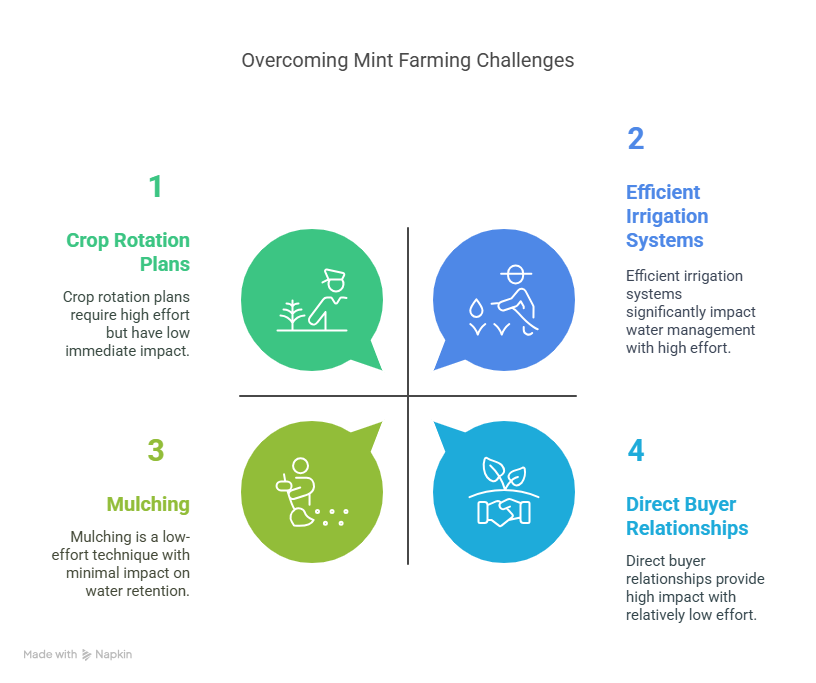
Ready to Start Your Mint Farming Journey?
Mint farming in Kenya offers a promising opportunity for farmers looking to diversify their production and access new markets. With relatively low maintenance requirements, multiple harvest cycles, and diverse market applications, mint can provide a steady income stream throughout the year.
If you’re considering mint farming, start small, perhaps with a quarter-acre plot, to learn the ropes before scaling up. Connect with existing mint farmers or agricultural extension officers for practical advice specific to your area.
Remember, the key to successful mint farming lies in proper planning, water management, and establishing strong market linkages. With determination and the right approach, this aromatic herb could become your next profitable agricultural venture.
Have you tried growing mint or other herbs commercially? Share your experiences in the comments below!




